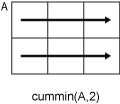cummin
累积最小值
说明
M = cummin(A)A 的累积最小元素。
如果
A是向量,则M是具有相同大小和类型的向量,并且包含A的累积最小值。如果
A是矩阵,则M是具有相同大小和类型的矩阵,并且包含A的每列中的累积最小值。如果
A是多维数组,则M是具有相同大小和类型的数组,并且包含沿A的第一个大小不等于 1 的数组维度的累积最小值。如果
A是表或时间表,则cummin(A)返回包含每个变量的累积最小值的表或时间表。 (自 R2023a 起)
M = cummin(___,direction)cummin(A,2,"reverse") 通过从尾到头计算 A 的第二个维度返回 A 的累积最小值。
示例
输入参数
提示
利用许多累积函数中的
"reverse"选项可以快速执行定向计算,而不需要翻转或反射输入数组。

